A Structural and Energetic Model for the Slow-Onset Inhibition of the Mycobacterium tuberculosis Enoyl-ACP Reductase InhA.
Li, H.J., Lai, C.T., Pan, P., Yu, W., Liu, N., Bommineni, G.R., Garcia-Diaz, M., Simmerling, C., Tonge, P.J.(2014) ACS Chem Biol 9: 986-993
- PubMed: 24527857
- DOI: https://doi.org/10.1021/cb400896g
- Primary Citation of Related Structures:
4OHU, 4OXK, 4OXN, 4OXY, 4OYR - PubMed Abstract:
Slow-onset enzyme inhibitors are of great interest for drug discovery programs since the slow dissociation of the inhibitor from the drug-target complex results in sustained target occupancy leading to improved pharmacodynamics. However, the structural basis for slow-onset inhibition is often not fully understood, hindering the development of structure-kinetic relationships and the rational optimization of drug-target residence time. Previously we demonstrated that slow-onset inhibition of the Mycobacterium tuberculosis enoyl-ACP reductase InhA correlated with motions of a substrate-binding loop (SBL) near the active site. In the present work, X-ray crystallography and molecular dynamics simulations have been used to map the structural and energetic changes of the SBL that occur upon enzyme inhibition. Helix-6 within the SBL adopts an open conformation when the inhibitor structure or binding kinetics is substrate-like. In contrast, slow-onset inhibition results in large-scale local refolding in which helix-6 adopts a closed conformation not normally populated during substrate turnover. The open and closed conformations of helix-6 are hypothesized to represent the EI and EI* states on the two-step induced-fit reaction coordinate for enzyme inhibition. These two states were used as the end points for nudged elastic band molecular dynamics simulations resulting in two-dimensional potential energy profiles that reveal the barrier between EI and EI*, thus rationalizing the binding kinetics observed with different inhibitors. Our findings indicate that the structural basis for slow-onset kinetics can be understood once the structures of both EI and EI* have been identified, thus providing a starting point for the rational control of enzyme-inhibitor binding kinetics.
- Institute for Chemical Biology and Drug Discovery, ‡Laufer Center for Physical and Quantitative Biology and §Department of Chemistry, ∥Graduate Program in Biochemistry and Structural Biology, and ⊥Department of Pharmacological Sciences, Stony Brook University , Stony Brook, New York 11794, United States.
Organizational Affiliation:





















